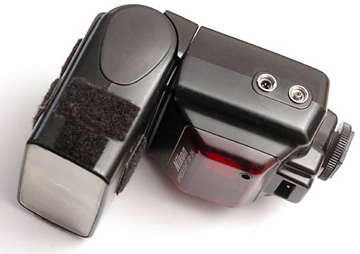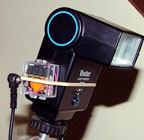Saturday, I shot the Towson/Drexel men's college basketball game for The Sun. I knew Strobist reader
Patrick Smith would be there, and I knew he would be using the school's house strobes.
(Patrick is a photographer for Towson U's newspaper,
The Towerlight, specializing in shooting sports and beer.)
For the record, we have the rights to use the university's house lights, too. In fact, as the local metro daily shooter, I am pretty sure the
fine folks at Towson University's sports info department would let me (a) bump Patrick off of the lights, and (b) order him to be wash my car in the parking lot while I am shooting the game. (Don't tell him I said so.)
So I decided to use two Nikon SB flashes to augment the house sodium vapor lights in the gym. This also makes for a good time to compare what you can do with a couple of hot-shoe flashes, vs a few thousand watt-seconds (and dollars) of AC-powered, permanent strobes.
Before we get into specifics, let's look at the advantages of the two different systems:
Big, Honker Studio Strobes:• Tons of light. Even bounced off of the ceiling (the Towson coach nixed the direct lights) they give you a solid 2.8 at ~ASA 400, everywhere on the court.
• Soft, pretty light (from the bounce)
• You can disregard the ambient light color temp, as the strobes totally trump the sodium vapes.
Little, Dinky SB Strobes:• You can move them from venue to venue. (The biggies are pretty much permanent. Only SI trots them around regularly.)
• Recycle time: With
Lumy turbo batts, I can fire my flashes eight times (on 1/4 power) while Big Lights Guy is counting,
"one thousand... two one thousand...," after each shot. Even with Ni-MH AA's, I could get four 1/4 power shots off in a second.
• Oh, yeah: A couple thousand dollars cheaper.
_______________________
Don't get me wrong. The big lights are great if they are (a) aimed well and (b) you can justify the money for installing them in an arena. Smart photogs work out agreements with arenas and then rent out the lights (when they do not need them) to help cover the up-front costs.
But this article is about how to use the little flashes. So we'll set the Duke Nuke'em flashes aside for the moment.
What I am doing is different than the way I
usually shoot hoops. Instead of using the strobes as the main light and the ambient as fill, I am gonna use the ambient as main and the strobes as fill.
Do not be biased for one method over the other. Go with what is presented to you. In this case, my flashes were not powerful enough to nuke the ambient, so I decided to enhance the ambient a little.
When I arrived, the ambient lights were better than I had remembered. Seems TU had been getting more TV coverage, so they shelled out for more sodium vapes.
(Universal truth: There is
nothing a college will not do to facilitate more TV coverage. Ditto politicians.)
Actually, I could have shot available light with little problem. But where's the fun in that? Besides, there is a second floor walkway with a railing about 25 feet behind each basket that was just begging for SB's. So here's how (one way at least) to do it.
First things first: Assess the ambient light color. This is easier than it sounds. I shot an available light shot from the 2nd-floor walk with the camera set to daylight balance and chimped the result. Looked greenish - reasonably close to fluorescent.
"Close enough for government work" is all you are gonna get here, so I set the camera to fluorescent and shot another. Not too far off. So I
greened a couple of SB's and clamped them to the railing.

I use the cheapo, lime-green Home Depot clamps - just 99 cents each. The orange ones are the same size, but cost $3.99. (I assume the green ones are not ripe yet, and thus 1/4 the price.) I modded them by adding another 37 cents worth of 1/4 x 20 bolt and a couple of nuts. Then I attached the spare 3/8" stud that comes on the Dot Line umbrella brackets I bought from
MPEX. A little gaffer's tape to strengthen the clamp even more and you are out the door for well under $2.00.

Now, the umbrella brackets mount right on the clamps. Cool, huh?
Yep, in the big leagues no expense is spared in the mounting of lights. Even more impressive is that I paid for the clamps, bolts and nuts in
cash, baby. Need secure lights to a railing? Just whip out your good friend, "Abraham Lincoln," and see if he can persuade the guy in the orange apron to hook you up with the parts for a remote mounting system.
Back to the ambient, it's not that it is all that bad in this gym. But it is coming from a bad direction (top down) if you are on the hardwood under the basket shooting up. So augmenting the light from slightly above and behind the basket is going to help it out a lot.
Flashes greened, another test pop shows that I am pretty balanced at 1/4 power with a 50mm beam spread (at ASA 640 at a 250th of a sec.) One very important thing to note is that I am not pointing the flashes down at the players so much as skimming them at head height.
This is to feather the light. I do not want it to be too bright under the basket and too dim at the top of the key. Aiming them up a tad evens things out, as the closer the players are, the more they are at the edge of the beam.
As an added bennie, the lights can reach far out into the court (example below.) Amazingly, they will be adding some nice fill even at the other end. This even surprised me. Flashes balanced and tested, I head down to shoot the game.
I have not shot a lot of hoops this year. Truth be told, I am a little rusty. So as insurance I went up into the stands to shoot the first five minutes of the game with a 80-200 up in the stands, straight across the sidelines from the rim, at rim height.

I do this as insurance. First, it is very easy to get something from here, as the angle is straight across to the basket. You can just pre-focus and let the players come to you. Also, if the beeper goes off three minutes into the game to send me somewhere else on spot news, I know I will have a couple of good shots. Further, this will give me a different looking "B" or "C" photo than the baseline action stuff.
Easy, and good variety when compared to the baseline stuff. Works for me. Five minutes into the game I move down to the baseline to shoot along with everyone else. But if I had to, I could have left at that point with good action.
Now's a good point to show the effects of the flash vs pure ambient.

Here are the refs, with no flash. This is the baseline exposure which takes into account the ambient light without having to over expose the ceiling because the light is really coming from the wrong direction.

Here they are, same exposure, with the flashes turned back on. Honestly, the fact that they are lit is not even that obvious if you had not seen the other pic. Remember, we are not nuking the ambient so much as fleshing it out. The flashes, coming from the top/front of the direction the action is going to be facing, are basically filling the shadows and compressing the tonal range of the photos.

Here is what the light looks like from the baseline at my end of the court. It has a lit-but-not-overpowered look that I like, given how little hardware I am using to do the job.
I also like that I can just set my motors to run at a max of 4 FPS and not worry about recycle times unless I fire more than eight shots in a continuous burst. (four shots at a time if using just AA's.) In both ways, this lighting style is a hybrid between available light and nuked gym.

Here is a shot from the same position of action at other end of the court, (with an 80-200.) I am clearly getting some fill from the flash even at this distance. In other frames, I can even see the shadow of the backboard on the far wall.
This gives clean, fast-sequence-shooting light. If the news of the game happened at the opposite end, I'd have it. At ASA 640 or 800, I can crop it in without too much grain. Not so at 1250 or 1600.
As an aside, we have big house lights in Comcast Arena for the Maryland Terps. But honestly, the shooting speed stops me from using them most of the time.
So, if you cannot afford the big lights, you can get most of the way there with creative use of your small strobes. They will be there when you need them, and you can easily fit the whole two-light kit in a small camera bag, clamps and all.
Next:
Special Q&A: Speedlighting a Gym This backlit twilight scene, by HeNkiS da Bro, looks like it could have come right out of the movie adaptation of Sin City.
This backlit twilight scene, by HeNkiS da Bro, looks like it could have come right out of the movie adaptation of Sin City. I have updated the sensor cleaning post from a few days ago. But thought it important enough to stick up top, too.
I have updated the sensor cleaning post from a few days ago. But thought it important enough to stick up top, too. Well, knock me down with a feather.
Well, knock me down with a feather.  Let me preface this post by noting that I am trying to get away from the "hey, look at this neat website" posts and more into the long-form, "On Assignment" and gear/technique stuff.
Let me preface this post by noting that I am trying to get away from the "hey, look at this neat website" posts and more into the long-form, "On Assignment" and gear/technique stuff. UPDATE #1: There is a Flickr thread with stories of people who have had problems doing this. Ditto someone that got the anti-aliasing filter messed up by the manufacturer's guys, too.
UPDATE #1: There is a Flickr thread with stories of people who have had problems doing this. Ditto someone that got the anti-aliasing filter messed up by the manufacturer's guys, too.  Cool photo by "PDPB". (See larger)
Cool photo by "PDPB". (See larger)
 Just a brief note to reserve the date if you are interested in attending a London lighting seminar.
Just a brief note to reserve the date if you are interested in attending a London lighting seminar.
 Next up is a little space-saving hack for the umbrella flash bracket. Literally. (He just took a hacksaw to his bracket and played with some bolts and epoxy.)
Next up is a little space-saving hack for the umbrella flash bracket. Literally. (He just took a hacksaw to his bracket and played with some bolts and epoxy.) And lastly, a neat little project that popped up in a cryptic photo posted in the discussion group. Check out this tutorial on how to build a slave for next to nuthin'.
And lastly, a neat little project that popped up in a cryptic photo posted in the discussion group. Check out this tutorial on how to build a slave for next to nuthin'.